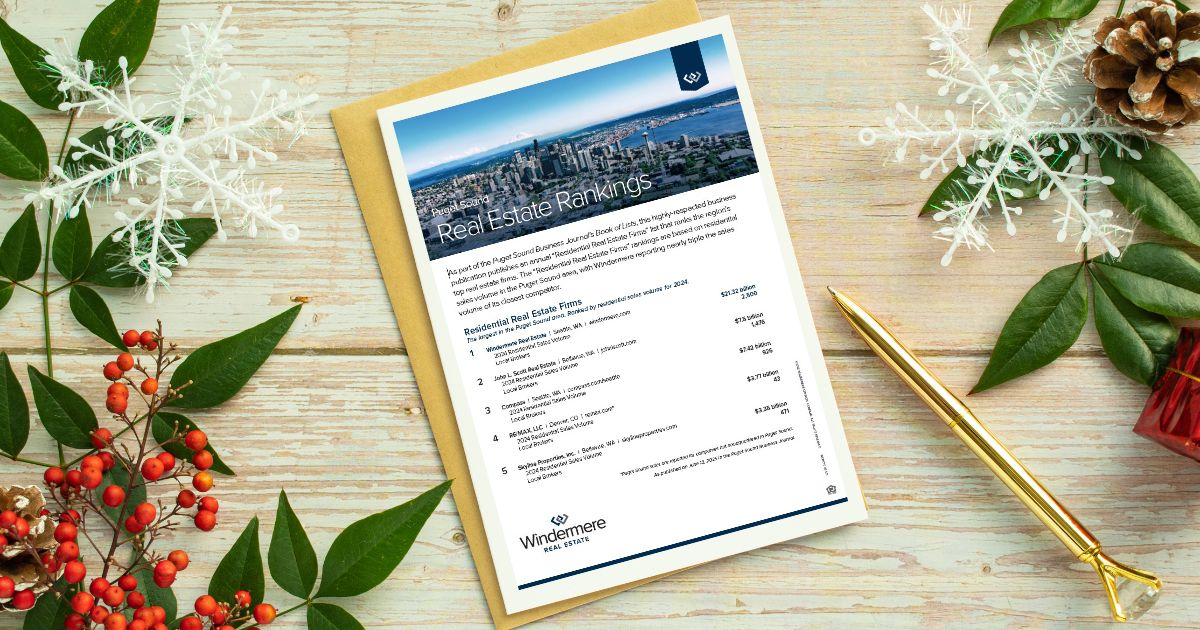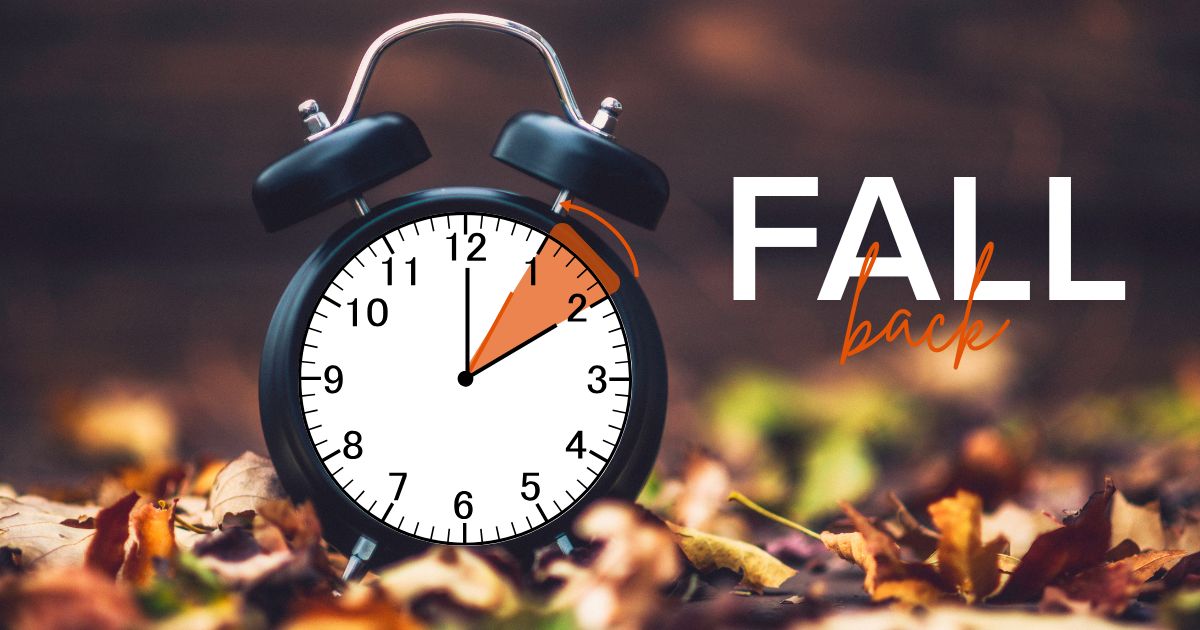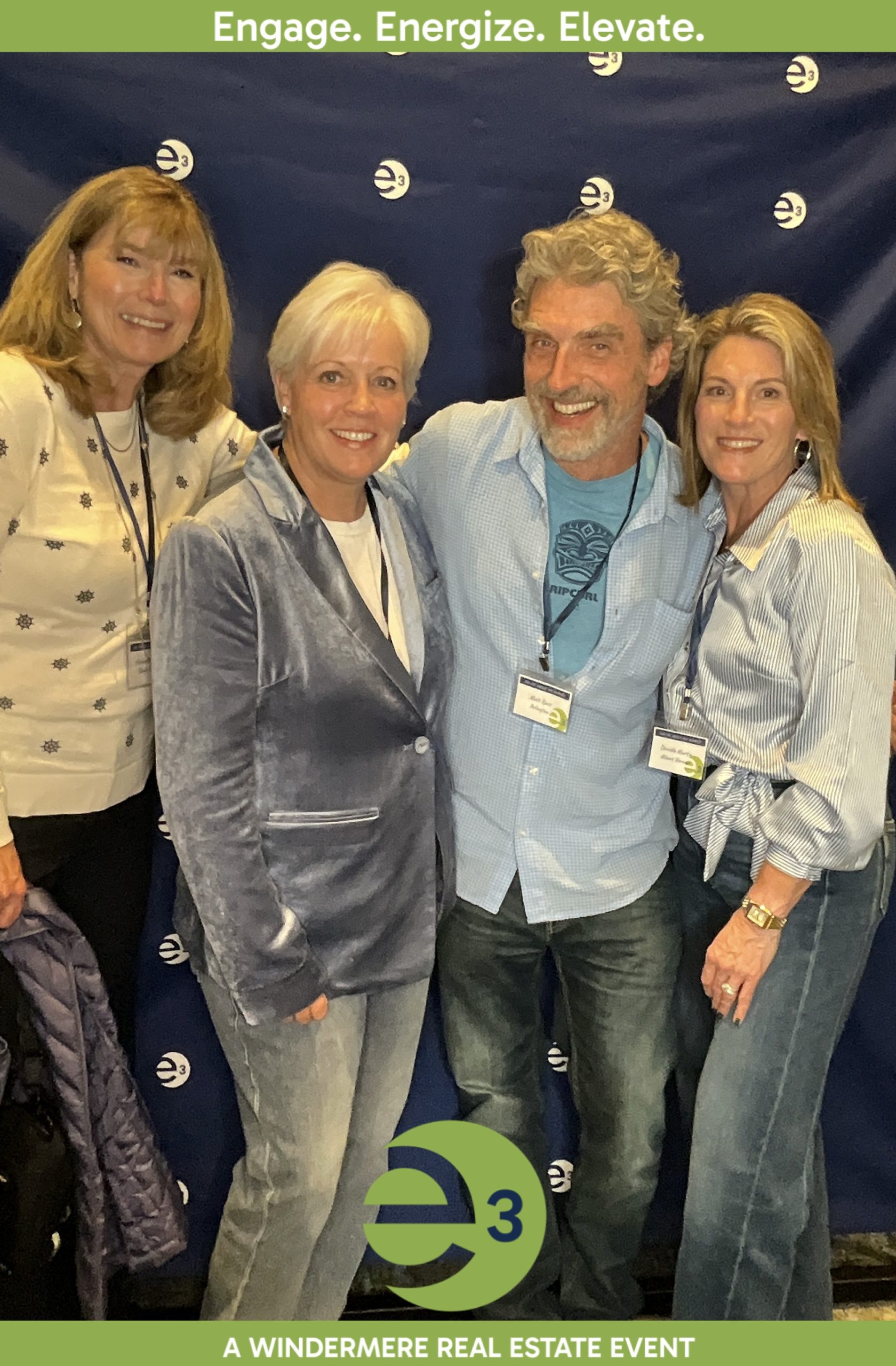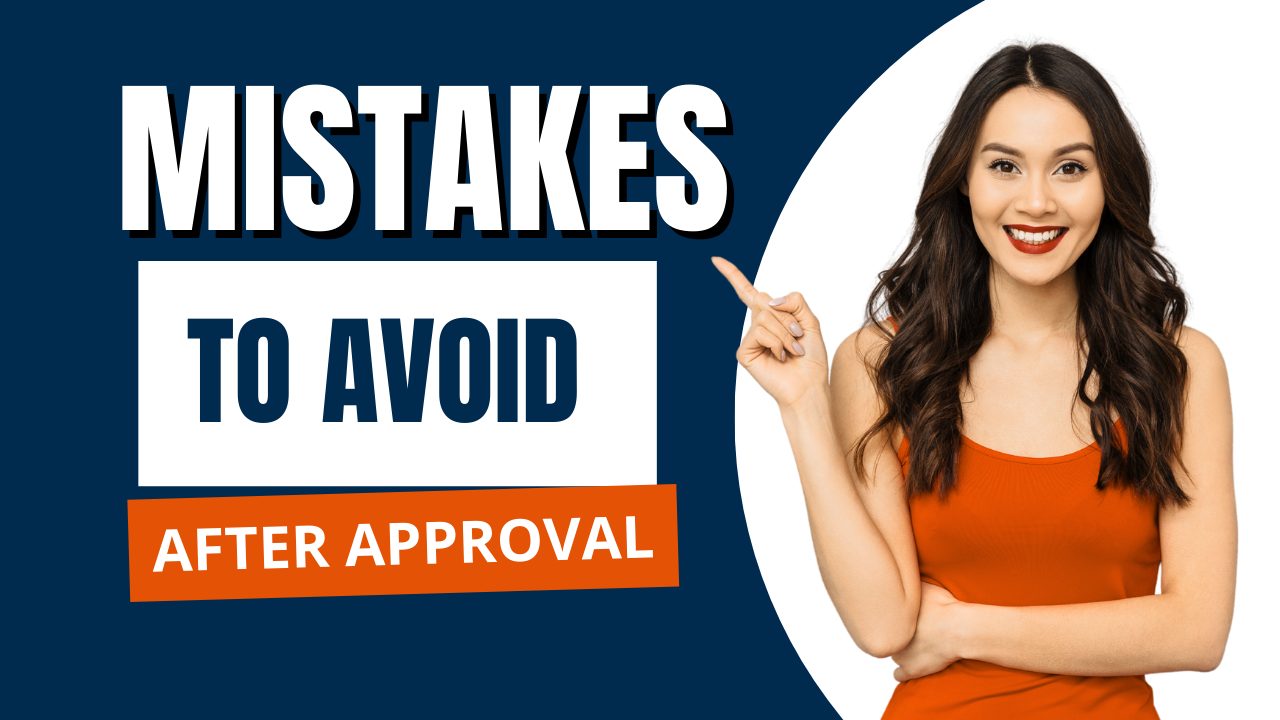A Legacy of Market Leadership

We were thrilled to see the Puget Sound Business Journal’s most recent real estate rankings (check them out here). Windermere has been a legacy of market leadership in the Puget Sound. The report supports this by demonstrating how Windermere Real Estate continues to assert its position as the foremost residential real estate firm in the Puget Sound region. Reporting $21.32 billion in residential sales volume. Windermere’s performance outpaces its nearest competitor by nearly a threefold margin. This information reinforces Windermere’s longstanding dominance in the regional housing market.
The history:
The Puget Sound Business Journal inaugurated its list of top residential real estate companies in 1986. Windermere has maintained the No. 1 ranking every single year. This nearly four-decade tenure highlights not only Windermere’s market share but its sustained organizational resilience, strategic adaptability, and strong community presence. We are extremely proud to be a part of it.
Factor of Success:
Several factors contribute to Windermere’s enduring success. First, its expansive network across the Pacific Northwest supports unparalleled market coverage and client reach. Second, the emphasis on agent education, technological integration, and customer-centered service has strengthened its professional reputation and operational efficiency. Finally, Windermere’s deep-rooted commitment to community engagement. The Windermere Foundation, funded in part by a portion of every home sold distinguishes Windermere as both a market leader and a socially responsible organization. As Windermere offices and agents in the Puget Sound, we couldn’t be more proud.
Here is a snip-it into what our Anacortes, Sedro-Woolley, Skagit Valley, and Arlington offices have been doing in our communities recently:





What it all means:
Windermere’s continued ability to outperform their competitors at such scale suggests a robust alignment between regional market demands and Windermere’s business model. Housing markets across the Puget Sound area evolve in response to demographic shifts, economic pressures, and ongoing development patterns. Windermere’s legacy of leadership positions it uniquely to shape the future trajectory of real estate services in the region.
In sum, Windermere’s top ranking is not merely a reflection of annual sales. Windermere’s top ranking is a testament to nearly forty years of consistent excellence, strategic foresight, and unwavering commitment to all of the communities served. We are grateful for your continued trust in our services and look forward to continuing to serve you for years to come.
If you are looking to making a move in your future please reach out. We would love to help you. If you wish to have a copy of this document mailed or emailed to you please email us at northsound@windermere.com.
Discover the Magic of Diablo Lake

Nestled in the rugged wilderness of the North Cascades, discover the magic of Diablo Lake. Diablo Lake is one of Washington’s most breathtaking destinations. It is a special place where turquoise waters meet dramatic mountain peaks, and every turn along the highway feels like you are stepping into a postcard. You will find Diablo Lake just east of the charming Skagit Valley communities. This natural wonder makes for the perfect day trip or weekend adventure for locals and visitors alike.
The Magic Behind the Color
One of the most captivating things about Diablo Lake is its brilliant blue-green color. The vibrant hue comes from “glacial flour”. A phenomenon where fine rock particles created by glaciers grinding against stone stay suspended in the water. When the sunlight reflects off the particles it creates the surreal blue-green tone of lake with an almost otherworldly glow. You must see it to believe it.
Things to Do Around Diablo Lake
Whether you are an adventurer, photographer, or someone looking for a peaceful escape, there is something for everyone.
Hiking:
Explore the popular Diablo Lake Trail, a 7.2-mile trail with stunning viewpoints of the lake and surrounding peaks. The complete trail includes an elevation gain of 1,509 feet and generally takes about 3.5 to 4 hours to complete.
Boating & Kayaking:
During peak seasons you can rent a kayak or join a guided boat tour to experience the lake from the water and learn about the area’s fascinating history.
Picnicking:
The Diablo Lake Overlook offers one of the most scenic picnic spots in the state. Don’t just drive by, this is a must-see for anyone driving along Highway 20. Pack a lunch and stop to enjoy the view.
Camping:
If you plan for an extended stay, there are nearby campgrounds like Colonial Creek that offer the chance to fall asleep under a blanket of stars, surrounded by the sounds of nature.
A Connection to Home
For those who call the Skagit Valley, or the surrounding areas home, Diablo Lake is more than just a destination, it is a reminder of why we live here. The North Cascades showcase the incredible balance between wild beauty and accessible adventure that makes the Pacific Northwest lifestyle so special.
Diablo is a place that inspires gratitude for the land we live on and the communities that protect it. Whether you are new to the area or a lifelong resident, taking the time to explore places like Diablo Lake deepens your connection to this incredible corner of the world.
Real Estate and the PNW Lifestyle
Living near places like Diablo Lake means having nature’s playground right in your backyard. For homebuyers seeking both tranquility and adventure, properties in Skagit and Snohomish Counties offer a gateway to this lifestyle. Those lucky enough to live here can enjoy weekends spent hiking mountain trails or relaxing by the water. Every season brings new reasons to fall in love with the Pacific Northwest.
Ready to Find Your PNW Home?
If the idea of living close to scenic trails, alpine lakes, and charming small towns sounds like your dream, let’s connect. We would love to help you discover a home that fits your lifestyle, whether that is a cozy cabin tucked among the trees or a home with a view of the mountains that make this region so magical.
📞 Reach out today to learn more about homes near the North Cascades, or explore listings across Skagit and Snohomish communities.
Make Shorter Days Work For You and Your Home

When the clocks turn back and daylight fades a little earlier, life in Skagit and Snohomish takes on a cozier rhythm. The fields, forests, and towns glow in fall colors. The evenings become an invitation to slow down and enjoy the comforts of home. This article will help you embrace the season and learn how to make shorter days work for you and your home.
A Seasonal Shift with a Purpose
Originally, Day Light Savings was created to maximize daylight hours. While “Falling back” is not always welcomed with an abundance of joy, it does offer a reminder that every season brings its own kind of productivity. “Falling back” gives us a bit more morning light. This early light offers us a great excuse to refocus on the spaces we spend the most time in.
Indoor Inspiration
As evenings begin to grow darker, we are provided the perfect opportunity to make our homes feel brighter and more functional. Here are a few ideas to help.
Refresh Your Entryway:
Try adding hooks for coats, a doormat for rainy-day shoes, and soft lighting to create a welcoming first impression.
Cozy Corners:
Layer textures with throw blankets, pillows, and rugs to make living spaces warm and inviting.
Brighten with Color:
Incorporate autumn tones like amber, rust, or olive in decor. These small changes add warmth to shorter days.
Clean & Prep:
Use that “extra hour” to tackle small projects before the holidays — clean windows, deep-clean the kitchen, or declutter high-traffic areas. *Pro tip: Winter is coming start planning for winterizing your home now.
Real Estate Reflections
Even as daylight fades, the housing market keeps moving. Buyers touring in the evening will notice how well a home feels at dusk. The soft lighting, a pleasant scent, and tidy organization all make a difference for how the home feels. Sellers can use this season to stage their homes for warmth and comfort, appealing to the desire for a welcoming space as winter approaches.
As we “fall back,” remember that shorter days don’t have to mean less light. It just means we shift where we find it. Whether it’s in your home, your community, or a new chapter ahead, there’s always something to brighten the season. If you are thinking about buying or selling, let’s connect!
Discover the Anacortes Beached Boat

A Day-Trip Treasure
When you’re exploring Anacortes, it’s easy to get swept away by the sparkling waters, island views, and charming downtown. However, tucked along the Guemes Channel Trail, discover the “Anacortes Beached Boat”. A hidden gem that’s equal parts history, nature, and Pacific Northwest quirk: the famous beached boat—officially known as the La Merced.
A Ship With Stories to Tell
The La Merced isn’t just any old vessel. Built in 1917 as a four-masted schooner for Standard Oil, she once carried petroleum products across the seas during the World War I era. Later, she was transformed into a floating cannery, working the Alaskan waters before finding her final resting place in 1966 at Lovric’s Boatyard on Fidalgo Island.
Rather than sail off into obscurity, the La Merced was scuttled and repurposed as a breakwater, protecting the boats in the marina from rough waters. And while her sailing days are long gone, she’s taken on a new kind of life.
Where History Meets Nature
Today, the La Merced is more than a shipwreck—it’s a forest on the water. Over the decades, trees and wildlife have taken root within her hull, turning this maritime relic into a floating ecosystem. It’s a rare sight: a schooner-turned-sanctuary where history and nature intertwine.
Because of her unique past and enduring presence, the La Merced was officially added to the National Register of Historic Places in 1990.
How to See It
If you’d like to experience this Anacortes landmark for yourself, the best view is from the Guemes Channel Trail, not far from the San Juan Islands ferry terminal. You can also catch a closer look from the adjacent marina parking lot, though remember—it’s an active boatyard, so be respectful of the space.
Why It’s Worth the Stop
The Anacortes Beached Boat isn’t just a landmark; it’s a reminder of how places—and vessels—can evolve over time. What once carried petroleum and canned salmon now holds trees, birds, and stories. It’s the kind of stop that adds a little wonder to your day trip, and one more reason to fall in love with the charm of Anacortes.
Whether you’re walking the trail, waiting for the ferry, or simply searching for something memorable to do in town, the La Merced is a must-see slice of PNW history.
If you loved this and are dying to learn more about our beautiful PNW area connect with us.
If you discover the Anacortes Beached Boat and wish to share your adventure tag us at @Windermere_Anacortes
Windermere E3

A reflection of our 2025 Windermere E3: Engage, Energize, Elevate event.
At Windermere, growth isn’t just about closing transactions. It is about elevating the experience for everyone involved, from our agents to our clients and communities. We grow together to better serve you. That spirit of growth and connection was at the heart of our recent Windermere E3 event held at the beautiful Suncadia in Cle Elum. Agents from across the region came together for a few unforgettable days of education, collaboration, and celebration.
Why being part of Windermere is so special
From networking to dancing the night away, the event was a vibrant reminder of what makes being a part of Windermere so special. Together we share a commitment to learning, supporting one another, and serving our clients with excellence.
Lead by the best in the industry to better serve you
Throughout the event, agents engaged in insightful sessions led by some of the best in the industry. Sharing strategies to enhance communication, improve client care, and stay ahead in a constantly evolving market. Every conversation, breakout session, and connection was focused on one goal: how to provide a better experience for the buyers and sellers we serve.
Supporting community needs
Beyond education, we also came together to give back. Together we raised $22,000 through live and silent auctions to support homeless families in need. It was a powerful example of how collaboration and compassion go hand in hand at Windermere.
When you work with a Windermere agent, you are not just working with a real estate professional. You are partnering with someone who is continually learning, evolving, and striving to deliver the highest level of service. Because when we engage, energize, and elevate each other, we elevate the entire experience of buying or selling a home.
A heartfelt thank you to everyone who made Windermere E3 possible. A special thank you to Shawna Ader for creating such an inspiring and impactful event.
At Windermere, we don’t just sell homes. We build relationships, strengthen communities, and continually push ourselves to be better for you.
If you are considering buying or selling and are in need of a real estate professional by your side, connect with us.
Pumpkin Season & Halloween Fun in Skagit Valley

The crisp autumn air settles in and the leaves beneath our feet start to crunch as a foggy tingle fills the air… Halloween is creeping closer! It’s time to conjure up some devilishly delightful pumpkin carvings, sip on warm cider, and soak up the magic of the season. Whether you are a seasoned pumpkin-carving pro or just getting started, Skagit Valley is brimming with inspiration, farm-fresh pumpkins, and festive events to make this fall unforgettable. Keep reading for the best ways to celebrate pumpkin season & Halloween fun in Skagit Valley.
Skagit Valley’s Pumpkin Patches & Fall Hotspots
Skagit Valley isn’t just a spring tulip paradise — fall is just as magical here, with sprawling pumpkin fields, cozy farm stands, and fun everywhere you turn. Here are some of the best places to find your perfect pumpkin (and maybe a little autumn adventure along the way):
Gordon Skagit Farms (Mount Vernon)
A Skagit Valley icon, Gordon Skagit Farms is known for its incredible variety of pumpkins, hand-painted farm signs, and elaborate fall displays. Wander through their fields, snap a few family photos, and explore their artistic, Halloween-themed barn.
Schuh Farms (Mount Vernon)
With its cheerful red barn and rolling pumpkin fields, Schuh Farms offers hayrides, u-pick pumpkins, delicious homemade pies, and fresh apple cider. It’s a true fall wonderland for all ages.
Tulip Town Harvest Festival (Mount Vernon)
Known for its spring tulips, Tulip Town transforms into an autumn festival in October, complete with pumpkins, local vendors, seasonal treats, and plenty of fall photo ops.
Jones Creek Farms (Sedro-Woolley)
Perfect for families, Jones Creek Farms offers not only pumpkins but also u-pick apples and pears. It’s a wholesome day out with a true farm-to-table feel.
Kristoferson Farm (Camano Island — just south of Skagit)
While technically outside the valley, Kristoferson Farm is worth the short drive for its fall market, pumpkin patch, and stunning seasonal scenery.
Spooktacular Pumpkin Carving Ideas
Once you’ve picked your perfect pumpkin, it’s time to get creative!
-
Classic Jack-o’-Lantern
– The timeless toothy grin never fails to deliver Halloween charm.
-
Ghostly Designs
– Paint or draw spooky faces for a quick, mess-free alternative to carving. Bonus: glow-in-the-dark paint is amazing.
-
Playful Cat
– Whiskers, pointy ears, and a mischievous grin for a whimsical touch.
-
Dragon Masterpiece
– For the ambitious carver, a dragon will wow trick-or-treaters.
-
Haunted House
– Carve intricate windows, ghosts, and creepy trees, then light it with twinkle lights for extra effect.
Halloween Happenings in Skagit Valley
Fall in Skagit Valley is filled with community spirit — and Halloween takes it up a notch. Keep an eye out for:
-
Mount Vernon Downtown Trick-or-Treat
– Local businesses open their doors for family-friendly trick-or-treating.
-
Anacortes Halloween Parade
– A festive small-town parade with costumes, candy, and fun for all ages.
-
Haunted Forest at Northern State Recreation Area
– A spooky trail experience perfect for thrill-seekers.
Whether you’re here for the pumpkin patches, the cozy farm vibes, or the eerie Halloween fun, Skagit Valley offers a little something for everyone this season. So, grab your scarf, your carving kit, and maybe a caramel apple or two — and make this fall one to remember.
Are you thinking about calling Skagit Valley home? We’d love to help you find your perfect place here — just in time for next fall’s pumpkin season. Let’s connect.
Mistakes to Avoid After Approval

Getting pre-approved for a mortgage is an exciting milestone—it means you’re one big step closer to owning your dream home. But don’t celebrate too soon! Between pre-approval and closing, there are critical do’s and don’ts that can make or break your transaction. Even small financial missteps, like opening a new credit card or making a large purchase, can put your loan at risk. To keep your home purchase on track, here are the most common mistakes to avoid after approval for a successful closing.
Make Large Purchases
Making a large credit purchase equates to increasing debt, which raises a buyer’s debt-to-income ratio. Large cash purchases decrease a buyer’s cash-readiness from the time when they were pre-approved. In both scenarios, the lender may call into question a buyer’s ability to make their mortgage payments.
Quit or Change Your Job
Knowing that a buyer has a stable source of income is important to lenders. Accordingly, it is best for a buyer to wait until after the home loan process is complete before taking steps to change their employment. Not only could changing jobs potentially put their mortgage pre-approval at risk, but it could also delay their settlement, since it takes time to prove a new salary.
Forget to Pay Your Bills
Missing bill payments can be especially harmful to a buyer’s candidacy in the time between getting pre-approved and closing on the home. During pre-approval, lenders are using your ability to pay bills on time to help them paint a picture of your finances and it’s important to keep that picture consistent.
Open a New Line of Credit
Opening new credit accounts will likely change a buyer’s credit score, which may cause adjustments in their interest rate. Lenders, upon seeing a new line of credit, even a store credit card, may elect to review the buyer’s risk of non-payment.
Pay Off Your Debt
While most people would think paying off debt is a good thing, if a buyer pays off any significant loans or credit card debt after pre-approval, their lender will want to know where the money came from. The decrease in debt will also have an effect on the buyer’s debt-to-income ratio, which may alter their creditworthiness.
If you found this information helpful and are preparing to purchase a home and don’t currently have an agent representing you, feel free to connect with us so we can help guide you through a smooth and successful home purchasing experience.
Minimize the Stress of Selling Your Home

Selling your home isn’t just a transaction — it’s the close of one chapter and the start of another. It’s packing up years of memories, navigating endless to-do lists, and stepping into the unknown. And while it can feel overwhelming, there are simple, intentional steps you can take to make the process less stressful and more empowering. Let us help you minimize the stress of selling your home.
Here’s how to move forward with confidence — and maybe even a little excitement.
-
Feel the Feelings
It’s normal to get sentimental. Your home has been the backdrop for milestones, laughter, and life’s little moments. Instead of brushing off the emotions, acknowledge them. Take a walk through each room. Snap photos of favorite spots. Hold on to the memories while making space for what’s next.
-
Start Decluttering — Early
One of the biggest stress triggers? Realizing how much stuff you’ve accumulated. Start small — one closet, one drawer, one room at a time. Keep what matters, donate what doesn’t, and toss the rest. Use this article to help guide your process.
If you struggle to let go of sentimental items, create a small “keepsake box” to preserve the most meaningful pieces. This helps you prepare your home for showings, showcases its best features, and positions it to sell for top dollar.
-
Look Ahead
Nostalgia is natural, but try shifting focus to what’s ahead. Whether you’re upsizing, downsizing, or relocating, visualize the possibilities. Create a vision board or jot down what you’re excited about in your next space. This keeps your energy moving forward instead of holding you back.
-
Lean on Your Real Estate Pro
You don’t have to do this alone. A great real estate agent will guide you through pricing, staging, marketing, and negotiations — so you can focus on your move, not the stress.
The sooner you bring your agent in, the better. They’ll help assess your home’s value, suggest improvements, and create a plan to get the best results. From market insight to moving tips, they’re your partner every step of the way.
-
Have a Moving Game Plan
Avoid last-minute chaos by breaking your move into manageable steps. Set target dates for decluttering, packing, repairs, and booking movers. A clear timeline makes the transition smoother and far less overwhelming.
-
Get Ahead on Repairs
A pre-inspection can help you spot and prioritize repairs before listing. Some fixes may be essential, while others might not impact your sale. Work with your agent to decide where to invest your time and budget — and ask about programs like Windermere Ready that can help cover upfront costs.
-
Embrace the Journey
Selling your home is both an ending and a beginning. Yes, you’re leaving behind memories — but you’re also stepping into new adventures, neighbors, and experiences. Home isn’t defined by the walls themselves, but by the love and memories you bring with you.
Bottom Line:
Selling your home can be emotional, but it doesn’t have to be overwhelming. With the right mindset, a plan in place, and a trusted real estate professional by your side, you can move forward with confidence.
Are you ready to start your next chapter? Let’s connect and make the process as smooth — and stress-free — as possible.

 Facebook
Facebook
 X
X
 Pinterest
Pinterest
 Copy Link
Copy Link



